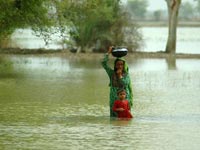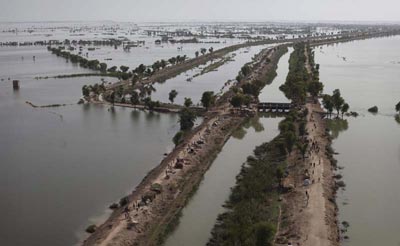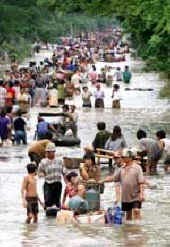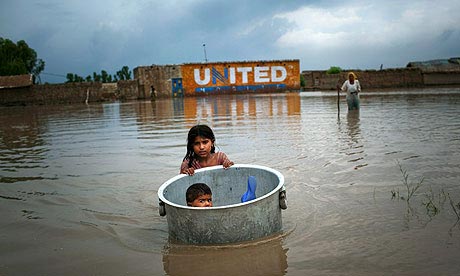The massive rainfall that struck Pakistan 
in July made the Indus river burst its banks. Large parts of Pakistan were flooded. This natural disaster, one of the largest natural disasters in the country’s history, already killed 1500 persons and an estimated 14 million other Pakistani (on a total population of 167 million) are badly affected. Meanwhile, one fifth of Pakistan’s total surface is flooded en 14 percent of the agricultural land is destroyed by the floodwater.
Experts testify that it’s not only a natural disaster. According to some of them the magnitude of the disaster was enlarged by the massive deforestation that took place in Pakistan. The trees on the river banks, serving as a natural buffer in the case of floods, have disappeared because of that. Other experts point out the great shortage of dams, water storages and banks. They also mention the lack of maintenance of the existing banks, canals and waterways. According to Transparency International (Transparency International Pakistan) that lack of maintenance is mostly due to corruption. The organisation, that among other things occupies itself with measuring the populations experiences with corruption, testifies of small and large-scale corruption within the Pakistani water sector. The use of bad materials has made the ravages bigger than necessary. Transparency international is fighting against corruption on all levels of the public as well as the private sector in Pakistan. The organisation acts as observer for the reconstruction of the stricken areas.

Aid organisations have warned numerous times for the lack of aid funds. The Western population in particular is not really inclined to open its wallet for the victims of the floods. That is partly due to the fact natural disasters are happening in such rapid succession that people are not prepared to donate every time. Contrary to previous stricken countries such as Sri Lanka and Thailand, Pakistan doesn’t have an extensive tourist sector, as a result of which people have less feeling for the stricken population. In the west, Pakistan is associated with Taliban, with terrorism and with the Islam in general. There’s also the visual aspect: apparently images of the ‘inhospitable’ Pakistan appeal less to one’s imagination than the images we got to see last year of the ‘tropical’ Haiti. To conclude, it’s also the task of the Western governments to set a good example to the population. Those governments haven’t been very generous at providing funds just yet.
 After over two months of floods, large areas of Pakistan remain submerged, as a result of which stagnant pools of standing water are created. Combined with the heat, these pools make a perfect breeding place for diseases such as malaria and cholera. More than 250.000 cases of suspected malaria have already been reported, including some of the fatal variations of the disease. Aid organisation Plan International (Plan International Pakistan) is afraid the figure will run to more than 2 million, with women and children being in danger most. The organisation has been active in Pakistan since 1997, fighting for the rights of marginalised children. At the moment, Plan International is offering emergency assistance in the heavily stricken areas Punjab and Sindh. The organisation provides the population with health and hygiene kits, helps constructing tent camps and installs water pumps in the camps.
After over two months of floods, large areas of Pakistan remain submerged, as a result of which stagnant pools of standing water are created. Combined with the heat, these pools make a perfect breeding place for diseases such as malaria and cholera. More than 250.000 cases of suspected malaria have already been reported, including some of the fatal variations of the disease. Aid organisation Plan International (Plan International Pakistan) is afraid the figure will run to more than 2 million, with women and children being in danger most. The organisation has been active in Pakistan since 1997, fighting for the rights of marginalised children. At the moment, Plan International is offering emergency assistance in the heavily stricken areas Punjab and Sindh. The organisation provides the population with health and hygiene kits, helps constructing tent camps and installs water pumps in the camps.

Millions of Pakistani that fled their homes have nothing left. Large parts of the harvest have been destroyed, as a result of which the food prices are rocketing. According to the aid organisation CARE (Cooperation for Advancement Rehabilitation and Education) (CARE Pakistan) around 20 million people have no food or clean drinking water. CARE organises free education in Pakistan and has set up a relief fund to help the victims of the floods. Initially the fund will be used to provide people with water, food parcels and other necessary means such as bug spray. At a later stage it will help to fund the reconstruction.




